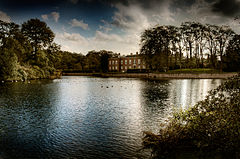Dunham Massey
| Dunham Massey | |
|---|---|
 Dunham Massey Hall |
|
| Dunham Massey shown within Greater Manchester | |
| Population | 475 (2001 Census) |
| OS grid reference | SJ740876 |
| • London | 200 miles |
| Metropolitan borough | |
| Metropolitan county | |
| Region | |
| Country | England |
| Sovereign state | United Kingdom |
| Post town | ALTRINCHAM |
| Postcode district | WA14 |
| Dialling code | 0161 |
| Police | Greater Manchester |
| Fire | Greater Manchester |
| Ambulance | North West |
| EU Parliament | North West England |
| UK Parliament | |
Dunham Massey is a civil parish in the Metropolitan Borough of Trafford, Greater Manchester, England. The parish includes the villages of Sinderland Green, Dunham Woodhouses and Dunham Town, along with Dunham Massey Park, formerly the home of the last Earl of Stamford and owned by the National Trust since 1976. Dunham Massey was historically in the county of Cheshire, but since 1974 has been part of Trafford Metropolitan Borough; the nearest town is Altrincham. At the 2001 census, the parish had a population of 475.
Dunham Massey's history is reflected in its 45 listed buildings. It was a regionally important place during the medieval period, and the seat of the Massey barons. The Georgian mansion with the remains of an castle in its grounds is a popular tourist attraction. There are two Sites of Special Scientific Interest in Dunham Massey: Dunham Park, located south of Dunham Town, and Brookheys Covert.
The Roman road between Chester and York passing between the Dunham Massey and Bowdon forms the boundary between the two. The name Dunham is derived from the Anglo-Saxon dun, meaning hill. The Massey element of the name is a result of its ownership by the Massey family. The manor of Dunham is recorded in the Domesday Book of 1086 as having belonged to Aelfward, a Saxon thegn, before the Norman Conquest and to Hamo de Masci afterwards. The Barons de Masci also had control over the manors of Baguley, Bowdon, Hale, Partington, and Timperley. The suffix of "Massey" to the name Dunham reflects the manor's importance; Dunham was the seat of the Masseys. The importance of Dunham is further exemplified by the former existence of two de Massey castles: Dunham Castle and Watch Hill Castle on the border with Bowdon; a third, Ullerwood Castle, was near Hale. The Masseys remained lords of Dunham and its environs until the 14th century, when the family's male line became extinct. The Booth family inherited most of the Massey family land in 1409, with Dunham Massey remaining at the heart of the estate.
...
Wikipedia

